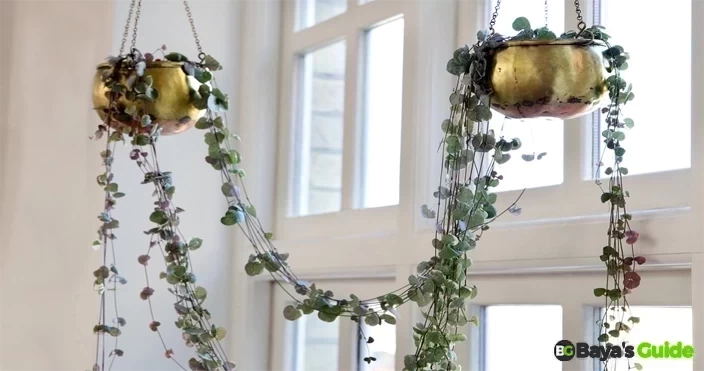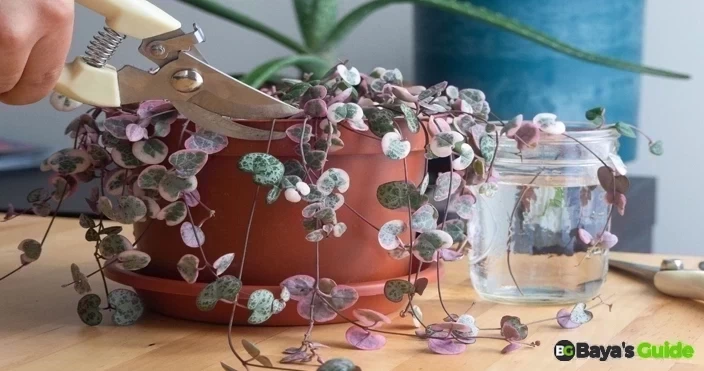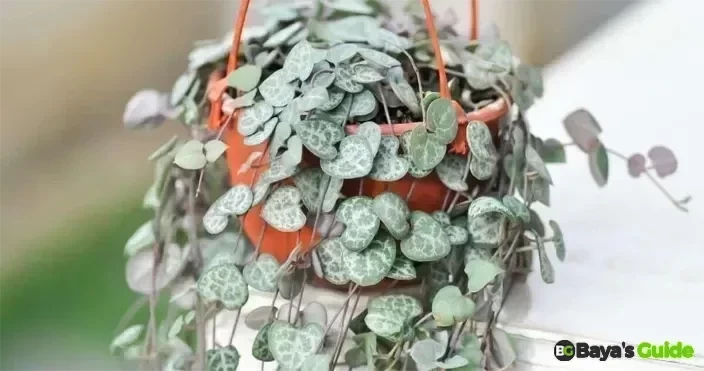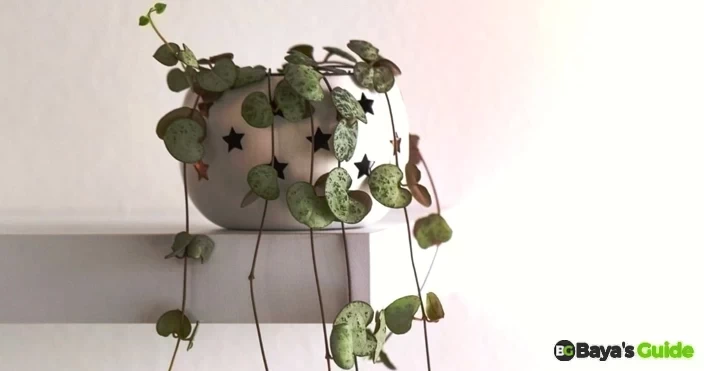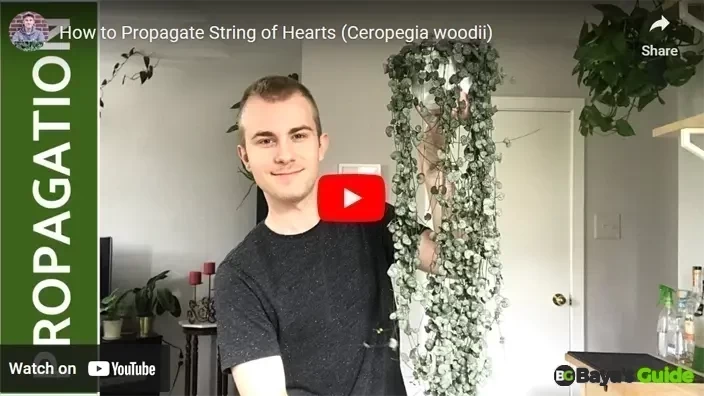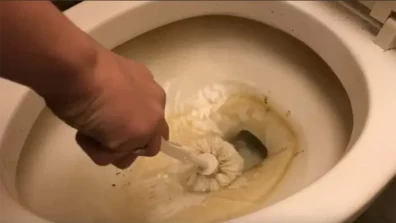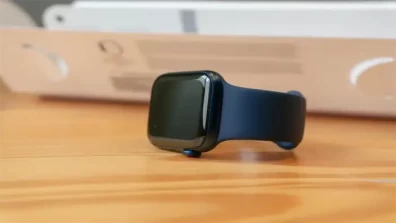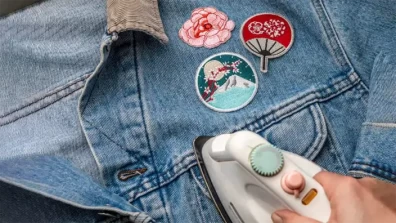A string of hearts – Ceropegia Woodii is a charming trailing succulent plant. It is popular for its cascading vines adorned. People like their small, heart-shaped leaves. Native to South Africa, it's a famous choice for indoor gardens and hanging baskets. They have a unique silver-green color with occasional hints of purple, making them an attractive addition to home decor. String of Hearts is relatively easy to care for and thrives in bright, indirect light. So, let's get to the point. Let me help you understand how to propagate string of hearts.
Here, I've been doing it to share my plants with my friends and relatives. And I'm going to share the easiest ways to help you propagate your String of Hearts. So, let's dig in…
Table of Contents
How To Make A String Of Hearts Fuller?
Whenever my friends or relatives visit our home, they always seem surprised to see the growth of my plants. And ask how I made the String of Hearts fuller. Well, the answer is really simple, i.e., by doing thoughtful propagation. So, let's jump to the first method, which is really simple and can be done in a few minutes.
Method 1: Cutting The Butterfly
To start propagation of the String of Hearts, hold one string in your left hand (if you're not a left-handed person) and proceed with the following steps.
1-Identifying The Butterfly
When you hold the string in your hand, try to find two leaves connected adjacent to each other. The two leaves will give the shape of a butterfly.
2-Cutting The Stem
Now, hold the stem joining the leaves and cut it from above them. The edge is called a String of Hearts' nodes from which the roots will come out.
3-Say Bye To Leaves
As you'll be putting the node in the water for further growth, the leaves will rot after some time. So, cut both leaves, and you'll have a bare node at the end of the stem with a continuing string of the hearts plant.
4-Get A Bottle Of Water
As soon as you cut the leaves, put the nodes in the bottle filled with water. Or you can use any other pot, but I prefer clear glass bottles. However, the same pot should have some drainage holes for the purpose of lowering the risk of root rot.
5-Wait & Wait
Before you place the cuttings, double if your node is perfectly submerged in the water. Then, start waiting for a few weeks (mostly 2 to 3) to see roots emerge.
6-Let The Roots grow
Since I've followed this method, let me quickly show you the growth process after multiple intervals.
- Day 9: You would have to wait more than a week to actually see the results. And when my cuttings reached day 9, some of them had already started to have growing roots.
- Day 28: After four weeks, most of my cuttings had roots on them with half-inch and one-inch long lengths. With that, let's move to the next step that you would need to do to get clusters of String of Hearts.
7- Put Baby Roots In The Soil
After 28 to 30 days, you'll have baby roots that need to be transferred to the soil. However, ensure they are at least half to one inch long.
8- Set The New Plant In The Soil
Make sure you have a small pot with highly enriched soil. Then, set the plant in the soil. Make 4 to 6 holes with anything and place the roots while putting the plant's shoots on the soil in a spiral manner. So they can contact the soil and grow roots.
9- Fill The Pot With Cuttings
Keep adding your cuttings in the same manner. But I would suggest putting 6 to 8 cuttings per pot to get better results. This will give a nice look, with tiny trails getting off the pot.
10- Fix Your Soil
Now that you have put all the cuttings in ensure your baby's roots are covered thoroughly. You can add more soil to cover and gently press the soil without crushing the roots.
11- Don't Fear If Your Tips Die
I usually find my String of Hearts tips dying during propagation. So, if your tips die, don't panic because you'll find another tip coming out.
12- Watering Your Tiny Hearts
Now, for the nurturing part, understand that these plants are succulent; therefore, keep the soil moist for a few days and let it dry – continue with this cycle till you get your desired lengths.
13- Here Fall The Hearts
I usually like to put the shoots in a circular motion so that the strings of the hearts fall while covering the whole pot. But if you like to cover the front side, collect and drop the tiny shoots at the front of the pot.
You Might Also Like:How To Compliment A Guy On His Looks Over Text
Method 2: Using Strings Of Heart's Tubers
If you have an old plant, you'll find a whitish round String of Hearts, root balls, or tubers. These tubers store and carry necessary nutrients and water to supply the plant during tough times. And you can also use them to propagate your plant.
However, I'm not really a fan of this method, but I've tried it multiple times to experiment. So, let's see what you've to do first.
1-Select Heart Tubers
To start the propagation process, you need to choose multiple tubers with nodes (small buds). You can find them under the soil. And while you take them out, keep them attached to the vines.
2-Get A Medium-Sized Pot
As you will work with larger tubers, you need a pot that can easily house all the tubers. You can take up to 10 to 15 tubers.
3-Untangle The Tubers
While taking the tubers along with the vines, you need to separate each tuber without breaking the shoots.
4-Transferring The Tubers
Now that you have the tubers make holes in the soil according to the number of your selected balls and start placing each tuber in the hole. Make sure the node side is above the soil, and gently press the soil around each tuber.
5-Taking Care Of The Tubers
After completing the propagation process, maintain sufficient light, humidity, and watering after a few days to avoid excessive moisture.
6-Waiting For The Results
After two to three weeks, you'll notice shoots coming out from the nodes of the tubers while the shoots of the parent would be dead by this time.
7-Nurturing Newly Grown Plants
When you find the shoots grown a bit with a few small leaves, transfer each tuber to a new pot and take care of them, as I discussed in the first method.
Laying cuttings in sphagnum moss has proven successful for many gardeners, and I tried it as well. When it comes to tuber propagation, you have to use them once again but in a different sequence.
Methods To Make A String Of Hearts Fuller
| Method 1: Cutting The Butterfly | Method 2: Using Strings Of Heart's Tubers |
| Identify The Butterfly - Find Two Leaves Resembling A Butterfly | Select Tubers - Choose Tubers With Nodes Attached |
| Cut The Stem - Snip It Above The Leaves To Form Nodes For Roots | Prepare A Pot - Use A Large Pot To Accommodate Several Tubers |
| Remove Leaves - Cut Leaves To Leave A Bare Node On The Stem Top | Untangle Tubers - Carefully Separate Tubers Without Breaking Stems |
| Place In Water - Submerge Nodes In A Water-Filled Bottle For 2-3 Weeks | Plant In Soil - Make Small Holes, Place Tubers, & Pack Soil Gently |
| Transfer To Soil - Transplant Roots Into Enriched Soil | Care & Wait - Provide Light, Humidity & Water Then Wait For Shoots |
| Transfer & Nurture - Move Tubers To Separate Pots & Handle Them As In The First Method |
Frequently Asked Questions
Can You Propagate The String Of Hearts In Water?
Yes, you can easily propagate String of Hearts in water. The right way to achieve the best results lies in being mindful of certain factors. These include planting it in favorable growing seasons, like Summer or Spring, and choosing stem cuttings with an appropriate number of nodes from the original plant.
Also, changing the water quite regularly greatly impacts the plant’s growth. Lastly, the effect of a moderate room temperature, neither too cold nor too hot, is a significant factor that you should consider.
Where Do You Cut String Of Hearts For Propagation?
Propagating String of Hearts is quite an easy process, as we have discussed, and all you need is a few stem cuttings. Although most stem cuttings would work, pick the one with a handful of leaves for better growth.
Moreover, you also have to ensure the cuttings contain at least four to five nodes since new growth mostly starts at this part of the plant. So, you should care about these single-node cuttings.
What Is The Best Propagation For String Of Hearts?
As I’ve discussed the easiest propagation method, you can also try another propagation method for a String of Hearts that includes Sphagnum Moss. First, you would need to soak some Sphagnum moss and place it in a container. Take your stem cuttings, making sure they involve nodes and leaves, as I’ve shared in method 1.
After that, place these cuttings in soaked Sphagnum Moss, ensuring contact of nodes with the moss. Close the container and let the fresh air flow after 1 to 2 days while keeping it in a warm room.
You can expect the growth roots in about one to two weeks. As soon as you get the roots, transfer your plant into the soil for further growth.
Should I Propagate String Of Hearts In Water Or Soil?
To choose the right method for the propagation of String of Hearts, you need to familiarize yourself with the process. If you prefer to observe the entire growth process, use the water method. This method produces rapid growth in a very short period.
However, soil propagation can be your best pick if you are looking for a method that requires less effort and is comfortable with slower growth.
Should I Untangle String Of Hearts?
Untangling String of Hearts seems like a fun activity. So you should definitely go for it. Untangling and arranging the plant's vines gives off cozy and warm vibes. And you get to actually witness the famous waterfall look, for which this plant is also called Rosary Vine.
What Are The Balls On The String Of Hearts?
If you are someone who got their hands on this houseplant for the first time, you might be wondering what those white-colored balls actually are. And might have thought of them as a fruit or flower, but that is certainly not true.
Those white balls are aerial tubers, storage balls of this plant. These store water and nutrients for the plant to survive tough conditions. Moreover, tubers also play a vital role in propagation when they come in contact with soil.
Conclusion
I hope you've really enjoyed today's propagation methods for String of Hearts, and now you are ready to pick your gardener cap. While you start the propagation process, thoroughly read and choose the method that best suits you. And make sure you follow every step carefully to avoid any inconvenience. Ciao for now. See you next time!

